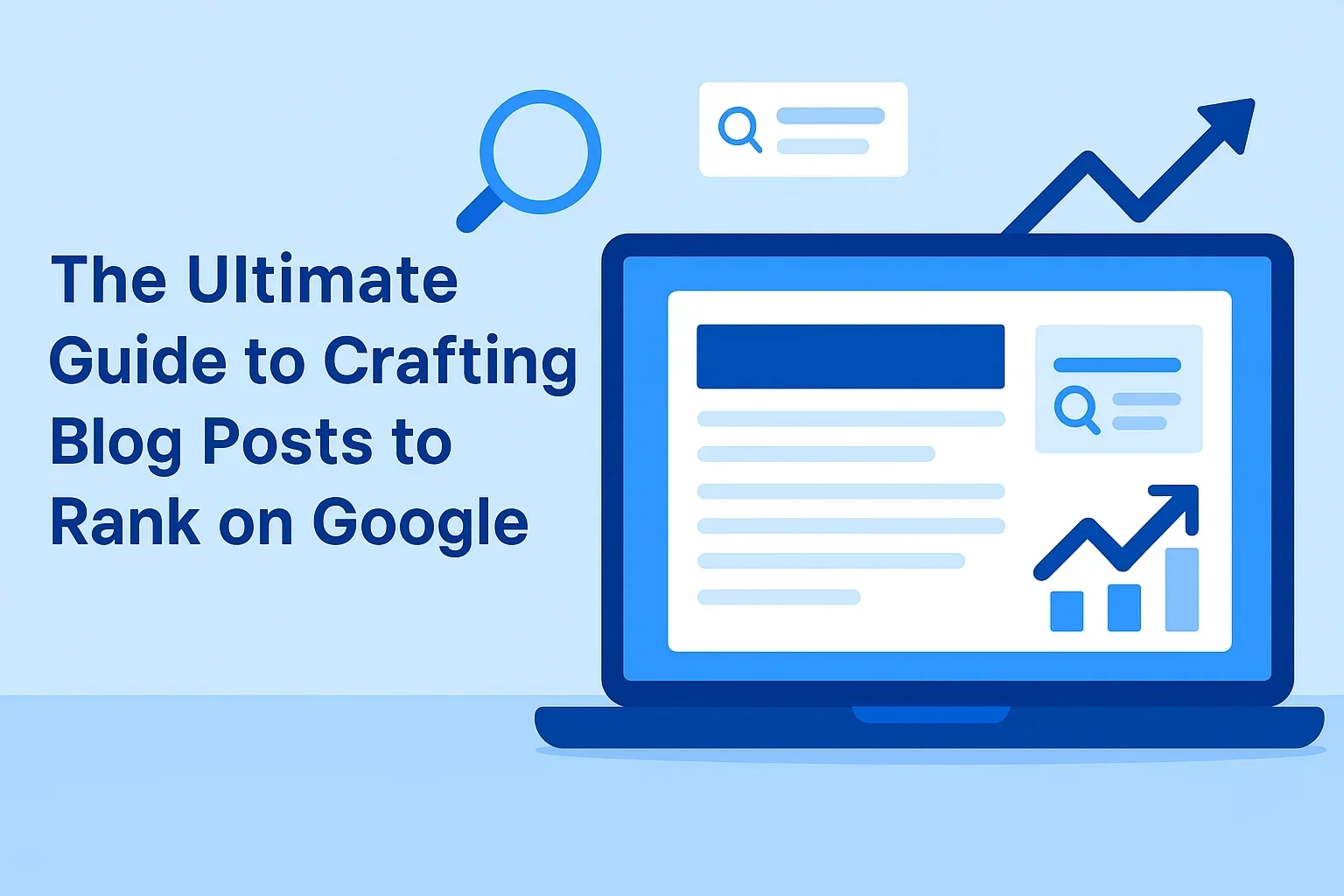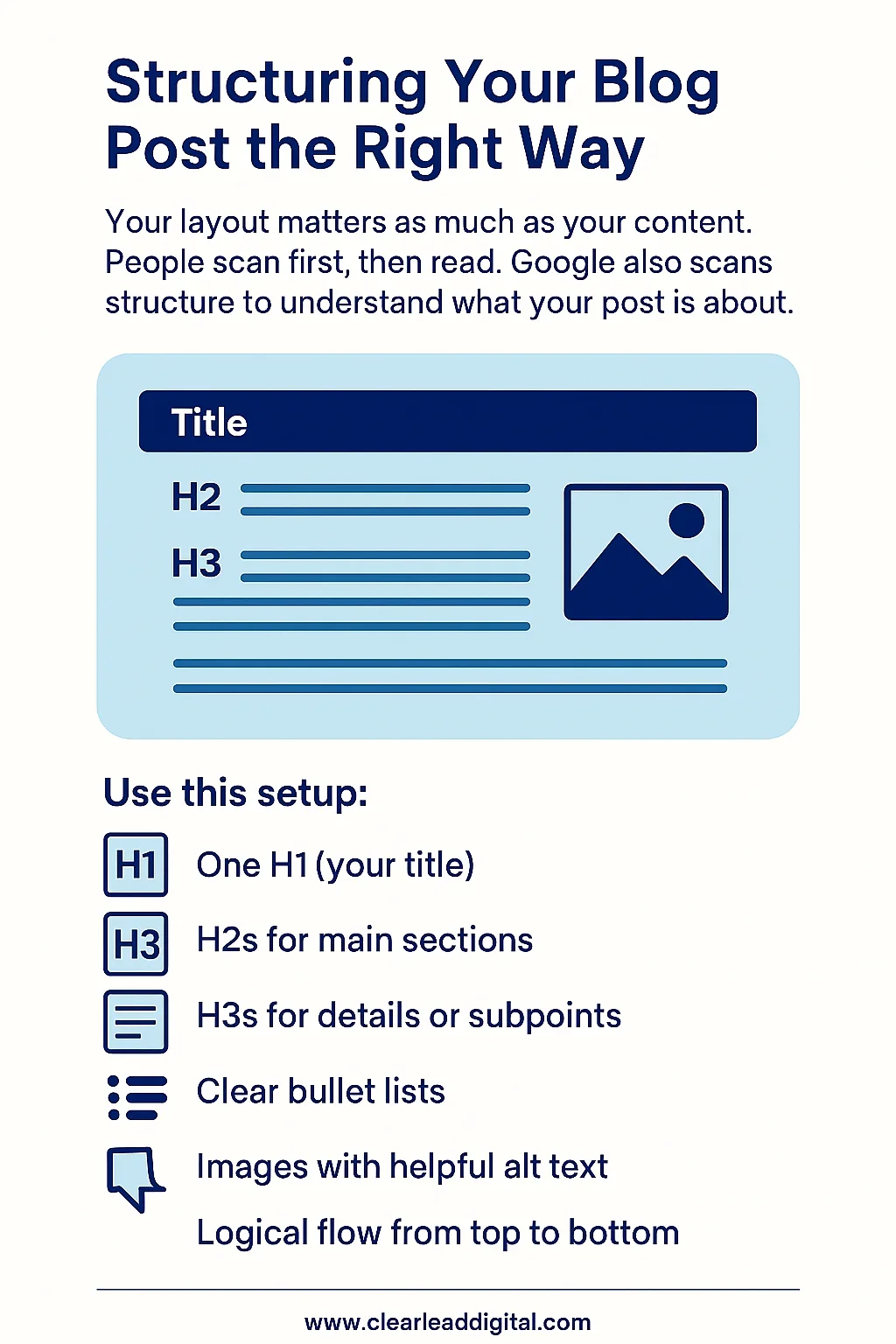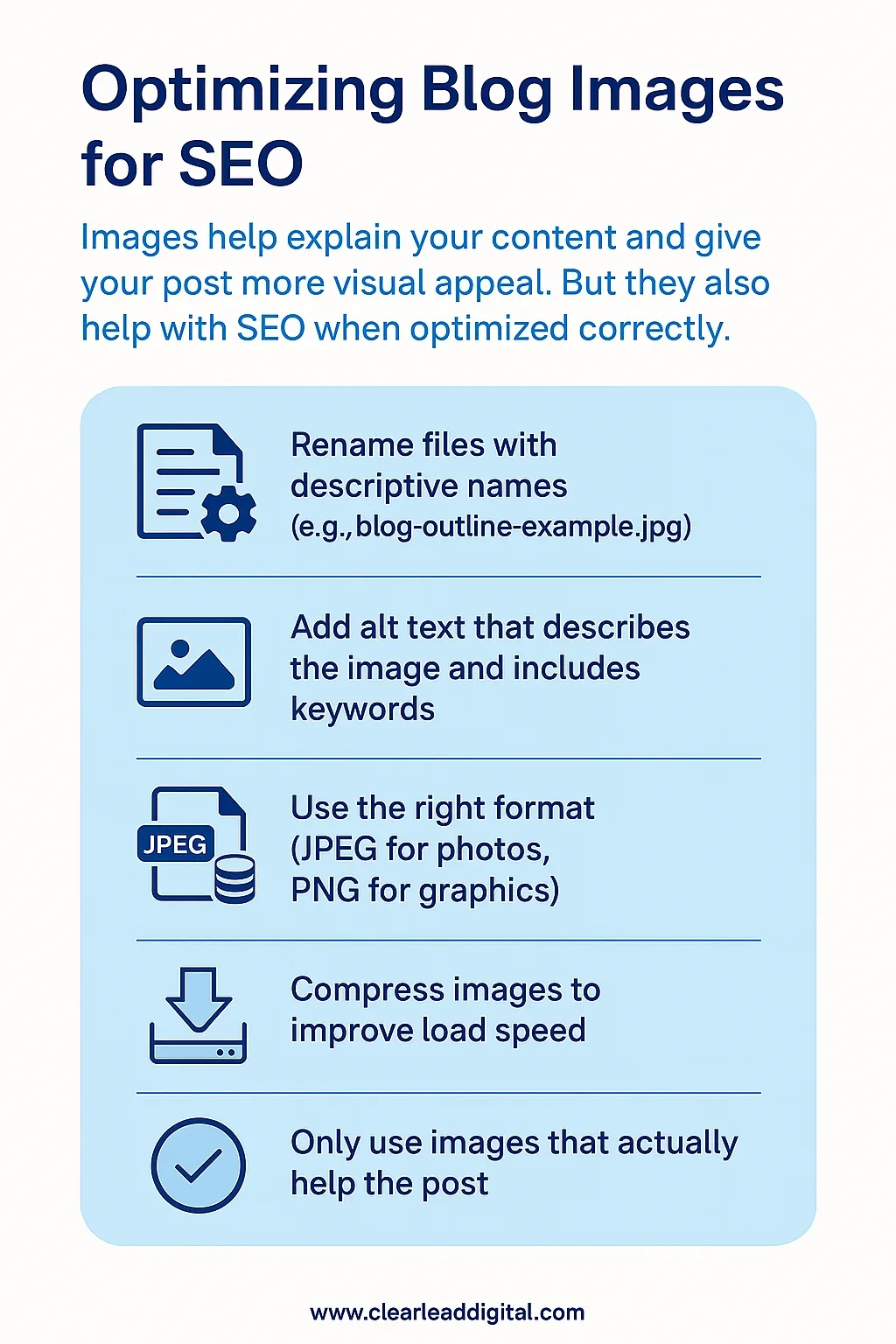The Ultimate Guide to Crafting Blog Posts To Rank on Google
Writing a blog post is simple. Writing one that ranks on Google takes planning and the right steps. Everything in this guide comes from proven SEO methods that help posts show up in search results and stay there.If you want to learn how to write a blog post that ranks, here’s exactly how to do it.
Table of Contents
What SEO Is and Why It Matters
SEO means Search Engine Optimization. It’s how search engines figure out which pages to show when someone types in a question. It looks at your content, structure, page speed, backlinks, and other signals.
If your post isn’t optimized, it won’t show up where people can find it. That means fewer views, fewer clicks, and less trust from readers. SEO is how you move from being buried on page five to getting found on page one.
Building a Simple Content Marketing Strategy
Start by asking a few questions. Who is this post for? What are they looking for? What problem are you helping solve? If you can’t answer those, your post probably won’t hit the mark.
Use keyword tools like Ahrefs, Ubersuggest, or Google autocomplete to figure out what people are typing. Terms like:
how to write a blog post that ranks
content marketing strategy
SEO blog writing tips
internal linking strategy
These are all worth targeting. Once you’ve picked your main topic, outline your post around it and build everything to support that search intent.
Pro Tip:
Check the top three Google results for your keyword. Then write something better, clearer, or more useful.
Writing for Search Engines Without Sounding Like a Robot
Google rewards content that helps people. That means clean, focused writing without keyword stuffing or robotic tone.
Here’s what makes a difference when you’re following good SEO blog writing tips:
Write short paragraphs
Use your keyword early, but naturally
Avoid repeating phrases just to check a box
Use variations like "rank in Google" or "SEO blog content"
Be direct and helpful
One thing people always ask about is ideal article length for SEO. Google tends to favor long-form content, especially when it fully answers a question. Posts between 1,500 and 3,000 words usually rank best, but only if every section helps the reader.
Example:
Bad: “SEO blog writing tips SEO blog writing tips SEO blog writing tips…”
Good: “Use these tips to make your blog easier for search engines to find.”
Structuring Your Blog Post the Right Way
Your layout matters as much as your content. People scan first, then read. Google also scans structure to understand what your post is about.
Use this setup:
One H1 (your title)
H2s for main sections
H3s for details or subpoints
Clear bullet lists
Images with helpful alt text
Logical flow from top to bottom
The connection between readability and SEO is strong. If your post is hard to follow, people leave fast. That bounce hurts rankings. Keep things simple. Use clear headings, short paragraphs, and plain language so people stay on the page longer.
Pro Tip:
Use tools like Hemingway or Grammarly to make sure your writing is clear and at the right reading level.
How Internal Links Help You Rank
Internal links connect your posts to each other. They help Google see how your content is organized and help readers find related info.
For example, if you mention keyword research, you can link to a full post about it with something like:
“Use these steps to build your keyword list.”
Good internal linking also spreads authority across your site. It shows Google which pages matter most. That’s the core of a smart internal linking strategy.
Stick to this rule:
Link to 2–5 relevant posts
Use natural anchor text
Make sure every important post gets linked to from somewhere
Getting Backlinks That Boost Authority
Backlinks are links to your site from other websites. They act like votes of trust. The more high-quality sites that link to you, the better your site looks in Google's eyes.
You don’t need thousands. A few good ones from trusted sources can make a big difference. This is how you build backlinks for blogs that matter.
Ways to get them:
Write helpful, original content
Offer a guest post
Submit your blog to relevant directories
Use HARO (Help a Reporter Out)
Create a free resource others want to reference
What to Do Before You Publish
Now that you’ve written the post, check these final steps before hitting publish.
Final checklist:
Keyword in title and first paragraph
H2 and H3 headers are used correctly
Images are compressed and labeled
Meta description includes your main keyword
Internal and external links are added
Page loads fast on mobile
Final proofread for grammar and flow
Once it’s live, get it in front of people:
Share on your social channels
Send it to your email list
Add it to any related blog posts
Post it in relevant communities or groups
Repurpose it into graphics, carousels, or short videos
Bonus: Optimizing Blog Images for SEO
Images help explain your content and give your post more visual appeal. But they also help with SEO when optimized correctly.
Here’s how:
Rename files with descriptive names (e.g., blog-outline-example.jpg)
Add alt text that describes the image and includes keywords
Use the right format (JPEG for photos, PNG for graphics)
Compress images to improve load speed
Only use images that actually help the post
Bonus: Schema Markup Explained
Schema markup is extra code that gives search engines more context about your content. You don’t need to write code to use it. Tools like Yoast or Rank Math can help add it automatically.
Adding schema can help your post appear with extra info in search results. This might include star ratings, FAQ dropdowns, or step-by-step instructions.
Common types:
Article
How-To
FAQ
Breadcrumb
Bonus: Analytics to Track After You Publish
Once your post is live, the goal is to improve it over time. That starts with tracking what works.
Use these tools:
Google Analytics: to see traffic and user behavior
Google Search Console: to monitor search performance
Ahrefs or Ubersuggest: to see backlinks and keyword data
Watch for:
How much time people spend on the post
What keywords you're ranking for
Which sections people skip or exit on
Update your post every few months. Add new info, fix outdated links, and keep it fresh so Google keeps ranking it.
Real Example: Ranking a Blog Post with This Strategy
A small business owner wanted to rank for the phrase “best email marketing tips.” Their old blog post was about 700 words and had no headings, no internal links, and barely any keyword focus.
Here’s what we changed:
Rewrote the intro to match the keyword and user intent
Added headings with clear H2s and H3s
Used the phrase “email marketing tips” in the title and intro
Linked to related blog posts
Included stats and examples
Added an FAQ section for long-tail keywords
Promoted it in niche forums
In four weeks, the post jumped from page 4 to position 6. A month later, it was top 3—no ads, just better SEO.
Common Mistakes That Hurt Rankings
Even with solid writing, small mistakes can ruin a post’s chance to rank.
Watch for these:
No keyword in the title or first paragraph
Walls of text that overwhelm readers
No internal links
Missing or weak meta descriptions
Clickbait headlines that don’t match content
No clear takeaway at the end
Fixing these often leads to quick wins.
Keeping Your Blog Posts Fresh: Republishing and Updates
Google rewards updated content. You don’t always need a new post. Refreshing old content can drive more traffic with less effort.
Do this:
Update outdated info or examples
Add new sections or images
Improve formatting and structure
Resubmit the post in Search Console
This is an underrated SEO strategy. It works.
Final Action Steps
Now that you know how to write a blog post that ranks, here’s what to do next:
Pick one of your existing posts
Run it through the checklist above
Improve structure, keywords, and flow
Promote it
Refresh it again in 3–6 months
Repeat that across your blog, and your organic traffic will start climbing.
Frequently Asked Questions (FAQ)
-
Include keywords you want to rank for in specific parts of your post.
Optimize the meta description.
Optimize your images alt text.
Link internally within your blog posts when possible.
Use Google's Search Console to monitor your rankings.
-
One big reason why your blog post is not ranking for your target keyword is because it is not relevant, or in other words, it doesn't give a good answer to the searcher's query. And it's not just about the relevance of that one blog post to the searcher's query. It's also about the relevance of the whole website
-
SEO is not necessarily hard to learn, but it does take time, effort, and persistence. If you are just starting and know nothing about search engines and how they work, you can expect to feel a bit overwhelmed initially, especially if you are trying to learn SEO on your own. However, it is important to keep trying.
-
Think before you write!
Devise a structure for your post.
Use paragraphs and headings.
Use transition words.
Use related keywords.
Optimize the length of your article.
Link to existing content.
Let other people read your post.
Get the complete guide we used to help property managers dominate their market.



